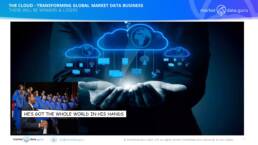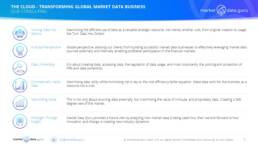

1.0 WELCOME TO THE LATEST CLOUD
With my Luddite tendencies nobody can accuse me of Technophilia, however even I must recognise the changes wrought by the Cloud, and The Cloud we know today is vastly different in concept and operation than its original form, and it is evolving rapidly.
The underlying driver is data workflows. My perspective is not technological, it relates to what is happening with the data once it becomes ensconced in the Cloud.
Starting as an over-hyped storage system, the natural evolution was access, firstly non-real time data, then real time data to the point that now data consumers can process information completely (should they wish) in a Cloud environment.
The Cloud has become multiple competing universes of connectivity, accessibility, and productivity.
Big Tech’s Cloud strategy is to drive original content to their own individual universe. Here it can be used productively, meaning ingestion, processing in decision tools with resultant outputs used to create actions, like a trade which can also be executed within the same environment.
For the banks and data consumers this means concentration, and fragmentation all at the same time. It will have a proportionately greater impact on smaller financial institutions because this simultaneously allows them to move costly internal systems into Clouds where third parties can use their heft to bring down marginal costs but also force them to engage with multiple Clouds because ‘must have’ datasets from, say, NASDAQ might only reside on AWS, or key benchmarks uniquely produced by Deutsche Börse are only accessible via Google.
For financial institutions this means solving a set of riddles.
2.0 UNRAVELLING THE MYSTERIOUS CLOUD
For any financial institution moving towards Cloud engagement means first validating its integrity, especially in terms of ensuring security. Assuming there are no issues the questions moves towards addressing three strategic challenges.
1 Rationale. Why I am doing this? What are the benefits, do my costs go down? Can I access a greater range of data, services, increase my productivity? In market data terms the potential for increased choice especially from new data sources in Alternative Data and ESG solves significant integration issues. Equally it provides opportunities for adopting new market data strategies, should incumbent data vendors and suppliers continue in situ or are there advantages in displacement?
2 Productivity. What shall I move to The Cloud? To what extent should internal systems be exported or even dropped in favour of third parties? It can be any, analytics, risk, portfolio management, trading? How market data is accessed is critical, legacy systems from a vendor, i.e. like Refinitiv’s TREP means a continued relationship with a specific provider, whereas a vendor neutral solution for instance BGGC Group’s ONE Platform provides options
3 Road Map. How shall I achieve my objectives? This is where technology centres the equation. A large organisation with multiple systems accessing a wide range of data from several sources is going to find this a challenge. The danger is Frankenstein hybrid environments being created as legacy systems mingle with not truly compatible Cloud native solutions, becoming ‘The Worst of Both Worlds’
Already the data consumers struggle because of the fundamental differentiation between those systems and solutions which are ‘in the Cloud’ and those ‘of the Cloud’.
It is not clear cut in terms of ‘Winners & Losers’. For data and solutions suppliers the winners will be those maximising data usage within a preferred cloud environment. Whereas for the data consumer it depends firstly upon the capability to create a genuine Cloud native strategy avoiding the pitfalls of ending up with a compromised environment, then secondly developing flexible policies to source, access, and consume market data.
Keiren Harris 26 April 2023
For our information on our consulting services please visit www.marketdata.guru/data-compliance
Or Email knharris@marketdata.guru
General contact info@marketdata.guru and to obtain a pdf copy of the article


